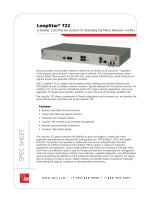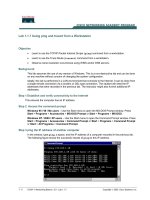Instructor InputsSession 1..Session OverviewThis session includes the following topics: .Net ppt
Bạn đang xem bản rút gọn của tài liệu. Xem và tải ngay bản đầy đủ của tài liệu tại đây (1.01 MB, 16 trang )
Instructor Inputs
Session 1
¤NIIT Instructor Inputs 1.3
This session includes the following topics:
.Net framework
SQL Server tools
Grouping data using the UNPIVOT operator
Best practices
Tips and Tricks
FAQs
Slide 1
Installing Windows XP Professional Using Attended Installation
Slide 1 of 14
Ver. 1.0
Querying, Managing, and Administering Databases Using SQL Server 2005
Objectives
Coll aborate Session 1
In this session, you will learn about:
.NET Framework
SQL Server 2005 tools
Grouping data by using the UNPIVOT operator
Best Practices while using the query statements in SQL
Server 2005
Tips and Tricks that will help you perform effective query by
using SQL Server 2005
FAQs related to general concepts of SQL Server 2005
Session Overview
1.4 Instructor Inputs ¤NIIT
Slide 2
Installing Windows XP Professional Using Attended Installation
Slide 2 of 14
Ver. 1.0
Querying, Managing, and Administering Databases Using SQL Server 2005
Knowledge Byte
Coll aborate Session 1
.Net Framework:
Is an environment used to build, deploy, and run business
applications.
Is designed to make significant improvements in code reuse,
code specialization, resource management, multilanguage
development, security, deployment, and administration.
Consists of the following components:
Development tools and languages
Base Class Library
Common Language Runtime (CLR)
Slide 3
Installing Windows XP Professional Using Attended Installation
Slide 3 of 14
Ver. 1.0
Querying, Managing, and Administering Databases Using SQL Server 2005
Knowledge Byte (Contd.)
Coll aborate Session 1
SQL Server 2005 provides various tools that help improve
the efficiency of database developers.
Some of the tools are:
SQL Server Management Studio:
Is a powerful tool associated with SQL Server 2005
Provides a simple and integrated environment for developing and
managing the SQL Server database objects
Business Intelligence Development Studio:
Is a tool that provides an environment to develop business
intelligence solutions.
Solutions are based on the data that was generated in the
organization and helps in business forecasting and making
strategic decisions and future
¤NIIT Instructor Inputs 1.5
Slide 4
Installing Windows XP Professional Using Attended Installation
Slide 4 of 14
Ver. 1.0
Querying, Managing, and Administering Databases Using SQL Server 2005
Knowledge Byte (Contd.)
Coll aborate Session 1
Database Engine Tuning Advisor:
Helps database administrators to analyze and tune the
performance of the server.
SQL Server Configuration Manager:
Helps the database administrators to manage the
services associated with the SQL Server.
UNPIVOT operator:
Allows database users to normalize the data that has earlier
been pivoted.
Transforms the multiple column values of a record into
multiple records with the same values in a single column.
Slide 5
Installing Windows XP Professional Using Attended Installation
Slide 5 of 14
Ver. 1.0
Querying, Managing, and Administering Databases Using SQL Server 2005
Best Practices
When you write stored procedures, triggers, and
user-defined functions, first decide whether to use traditional
Transact-SQL or a programming language that is
compatible with the .NET Framework, such as Visual Basic
.NET or C#.
Use Transact-SQL where the code primarily performs data
access with little or no procedural logic
Use programming languages when you have
computationally-intensive functions and procedures that
feature complex logic or for situations where you want to take
advantage of the .NET Framework class library.
To rotate the data of a table use the PIVOT and UNPIVOT
operators, instead of using complex JOIN statements.
Coll aborate Session 1
1.6 Instructor Inputs ¤NIIT
Slide 6
Installing Windows XP Professional Using Attended Installation
Slide 6 of 14
Ver. 1.0
Querying, Managing, and Administering Databases Using SQL Server 2005
Best Practices (Contd.)
Use the new data types VARCHAR(MAX),
NVARCHAR(MAX), and VARBINARY(MAX) for storing long
columns.
In the Query Editor Results window, use the Options tab in
Management Studio to set the maximum column size under
the Results section.
Keep the result sets that you return from your database
small to improve performance.
Coll aborate Session 1
Slide 7
Installing Windows XP Professional Using Attended Installation
Slide 7 of 14
Ver. 1.0
Querying, Managing, and Administering Databases Using SQL Server 2005
Tips and Tricks
Coll aborate Session 1
When writing calculation expressions such as “expr1 *
expr2”, ensure that the expression sweeping the largest
area/volume is on the left side.
Consider replacing simple “Measure1 + Measure2”
calculations with computed columns in the SQL data source.
Avoid using Select * in your query design. Instead,
ensure that you use the proper column names in the query.
¤NIIT Instructor Inputs 1.7
Slide 8
Installing Windows XP Professional Using Attended Installation
Slide 8 of 14
Ver. 1.0
Querying, Managing, and Administering Databases Using SQL Server 2005
What are the two new components introduced with SQL
Server 2005?
The two new components introduced with SQL are:
SQL Server Management Studio
SQL Server Business Intelligence Development Studio
Can we use the PIVOT and UNPIVOT operators in SQL
Server 2000?
No, SQL Server 2000 does not support the PIVOT and
UNPIVOT operators. To achieve the same functionality as that
of the PIVOT and UNPIVOT operators, you can use JOINS in
SQL Server 2000.
FAQs
Coll aborate Session 1
Slide 9
Installing Windows XP Professional Using Attended Installation
Slide 9 of 14
Ver. 1.0
Querying, Managing, and Administering Databases Using SQL Server 2005
Which framework is supported by SQL Server 2005?
SQL Server 2005 supports Framework V2.0.
Which application architecture does SQL Server 2005
support?
SQL Server 2005 supports n-tier architecture.
Which service of SQL Server 2005 allows you to gather and
integrate data from various disparate data sources available
in an organization?
Integration services of SQL Server 2005 allow you to gather
and integrate data from various disparate data sources
available in an organization.
FAQs (Contd.)
Coll aborate Session 1
1.8 Instructor Inputs ¤NIIT
Slide 10
Installing Windows XP Professional Using Attended Installation
Slide 10 of 14
Ver. 1.0
Querying, Managing, and Administering Databases Using SQL Server 2005
Challenge
Coll aborate Session 1
Which of the following is not a component of the .NET
Framework?
Development tools and languages
Base class library
Service Broker
Common Language Runtime
Answer:
Service Broker
Slide 11
Installing Windows XP Professional Using Attended Installation
Slide 11 of 14
Ver. 1.0
Querying, Managing, and Administering Databases Using SQL Server 2005
Challenge (Contd.)
Coll aborate Session 1
Which of the following component of the .NET Framework is
used to create the interface for the Windows forms?
Base class library
Service Broker
Development tools and languages
Common Language Runtime
Answer:
Development tools and languages
¤NIIT Instructor Inputs 1.9
Slide 12
Installing Windows XP Professional Using Attended Installation
Slide 12 of 14
Ver. 1.0
Querying, Managing, and Administering Databases Using SQL Server 2005
Challenge (Contd.)
Coll aborate Session 1
Which component of the .NET Framework provides an
environment for the application to run?
Development tools and languages
Base class library
Security Management
Common Language Runtime
Answer:
Common Language Runtime
Slide 13
Installing Windows XP Professional Using Attended Installation
Slide 13 of 14
Ver. 1.0
Querying, Managing, and Administering Databases Using SQL Server 2005
Challenge (Contd.)
Coll aborate Session 1
Which of the following is not a feature provided by the
common language runtime?
Service-oriented architecture
Language interoperability
Automatic memory management
Platform independence
Answer:
Service-oriented architecture
1.10 Instructor Inputs ¤NIIT
Slide 14
Installing Windows XP Professional Using Attended Installation
Slide 14 of 14
Ver. 1.0
Querying, Managing, and Administering Databases Using SQL Server 2005
Challenge (Contd.)
Coll aborate Session 1
Which of the following is not a main component of the SQL
Server Management Studio interface?
Solution Explorer
Query Editor
Object Explorer
SQL Server Client Agent
Answer:
SQL Server Client Agent
¤NIIT Instructor Inputs 1.11
1. c. Service Broker
2. c. Development tools and languages
3. d. Common Language Runtime
4. a. Service-oriented architecture
5. d. SQL Server Client Agent
Solutions to Challenge
1.12 Instructor Inputs ¤NIIT
1. What is the maximum length of NVARCHAR data type?
a. 8000 characters
b. 6000 characters
c. 4000 characters
d. 400 characters
2. Which of the following data type does not store integer value?
a. tinyint
b. int
c. smallint
d. decimal
3. Which operator is used to change the precedence of the arithmetic operators in SQL
queries?
a. \
b. [ ]
c. ( )
d. { }
4. Which of the following query retrieves the record of the students who are studying in
a class higher than class 10?
a. SELECT * FROM Student WHERE NOT class<=10
b. SELECT * FROM Student WHERE class=10
c. SELECT * FROM Student WHERE class>=10
d. SELECT * FROM Student WHERE NOT class>=10
5. Which of the following query retrieves the names of the cities that start with letter M
and whose fourth letter is B?
a. SELECT City FROM City_List WHERE City LIKE ‘M_ B_%’
b. SELECT City FROM City_List WHERE City LIKE ‘M_ _ B[]’
c. SELECT City FROM City_List WHERE City LIKE ‘M_ _ B%’
d. SELECT City FROM City_List WHERE City LIKE ‘M% B%’
6. Which SQL Server 2005 service provides data mining solutions that are built on data
integrated in the data warehouse?
a. Analysis services
b. Reporting services
c. Database engine
d. Integration services
Home Assignment
¤NIIT Instructor Inputs 1.13
7. Which type of statement in SQL Server allows you to control the data access in the
database?
a. DML
b. DCL
c. DDL
d. DQL
8. Which data type is used to store fixed length character data?
a. text
b. varchar(n)
c. char(n)
d. nchar
9. Which clause allows you to group data in a SELECT statement?
a. WHERE
b. HAVING
c. ORDER BY
d. COMPUTE BY
10. Which group operator is used to transform a set of columns into values?
a. COMPUTE
b. COMPUTE BY
c. GROUP BY
d. PIVOT
Solutions
1. 4000 characters
2. decimal
3. ( )
4. SELECT * FROM Student WHERE NOT class<=10
5. SELECT City FROM City_List WHERE City LIKE ‘M_ _ B%’
6. Analysis services
7. DCL
8. char(n)
9. COMPUTE BY
10. PIVOT
1.14 Instructor Inputs ¤NIIT
SQL Server 2005 provides a data management solution for the organization. It allows
secure and efficient storage and management of data. In addition, SQL Server 2005
provides other components and services that support the business intelligence platform to
generate reports and facilitate data analysis.
Discuss the role of each core component of SQL Server 2005 in an enterprise
environment.
Instructor Inputs
You can conduct the discussion as follows:
Begin the discussion by listing the different core components of SQL Server 2005.
Encourage the students to discuss about the data management support of database
engine.
Continue the discussion by mentioning about the data integration requirement of the
enterprises and role of Integration services in this context.
Move the discussion to the need of analysis services and reporting services.
Solution
The different core components of SQL Server 2005 are as follows:
Database Engine
Integration Services
Analysis Services
Reporting Services
Database Engine
The database engine provides support to store, query, process, and secure data on the
database server. The database engine contains databases and database objects, such as
tables and procedures. This database engine allows you to create and manage database
objects. Apart from providing support for data management, the database engine also
provides the following background services:
Service Broker: Provides support for asynchronous communication between clients
and the database server, enabling reliable query processing.
Replication: Allows you to copy and distribute data and database objects from one
database server to another.
Collaborative Exercise
¤NIIT Instructor Inputs 1.15
Full-text search: Allows you to implement fast and intelligent search in large
databases by allowing you to search records containing certain words and phrases.
Notification services: Allows you to generate and send notification messages to the
users or administrators about any event.
Integration Services
Organizations have their old data in the legacy data storage systems. This data they may
require in future for some analysis purposes. Integration services allow you to gather and
integrate data from various disparate data sources available in an organization.
Organizations can also have different branches and these branches of the organization
may use different data storage technologies to store the operational data. You can store
the data in a consistent format in a common database called the data warehouse using the
Integration services
Data is contributed from multiple branches of an organization, each using different
conventions and standards. Before the data can be used, it may need to be formatted
differently. For example, you may need to combine the first name and the last name into
one column. This standardization of the data can be done using Integration services.
Analysis Services
Analysis services help in data analysis in a BI application. These applications are built on
a data warehouse that contains data consolidated from various data sources. These
services provide data mining solutions that are built on data integrated in the data
warehouse.
Reporting Services
Reporting services provide support to generate comprehensive reports on data in the
database engine or in the data warehouse. These services provide a set of tools that help in
creating and managing different types of reports in different formats.
1.16 Instructor Inputs ¤NIIT









